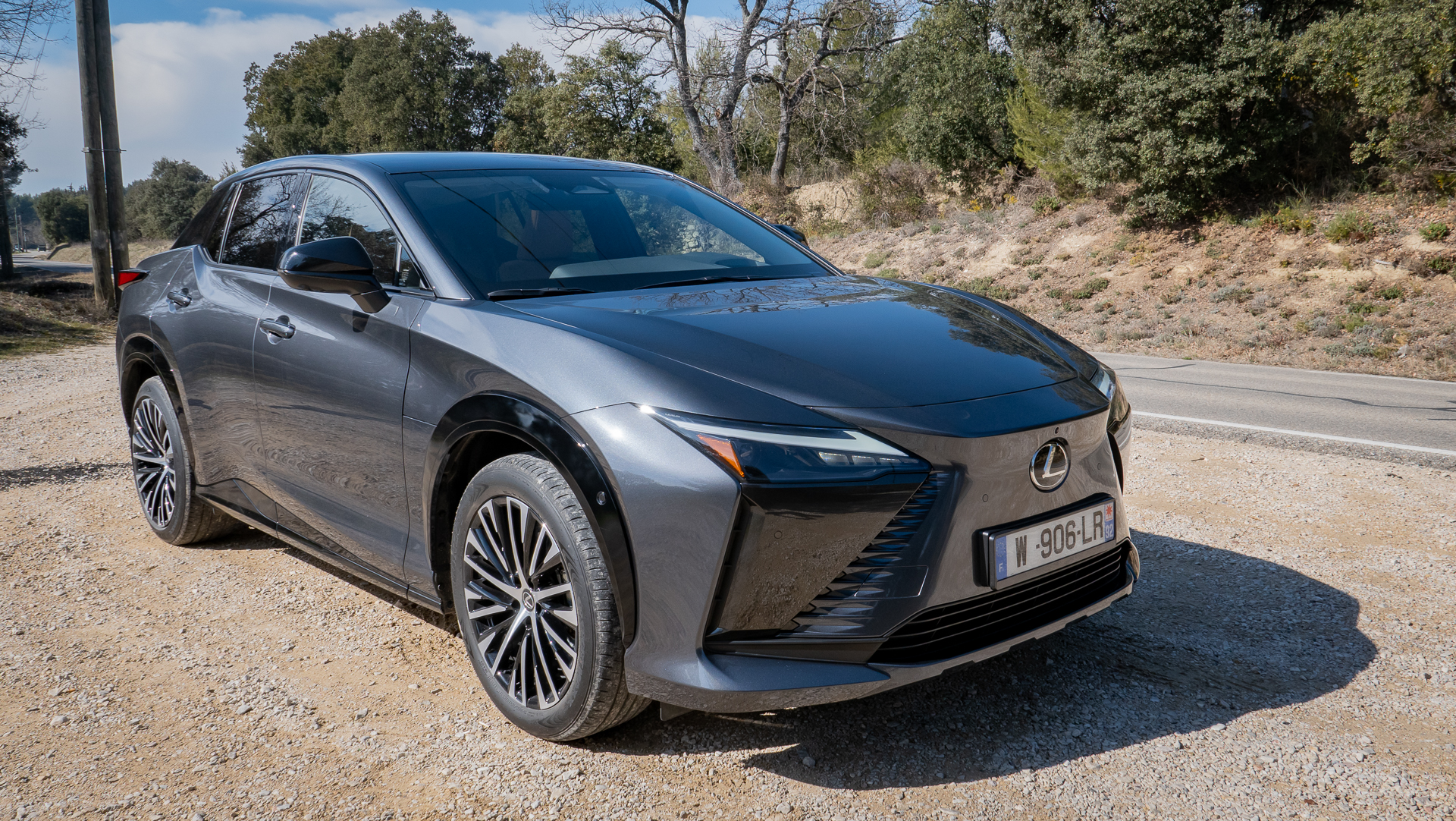

The RZ is a big deal for Lexus because, while almost all of the cars itsells in Europe are electrified to some degree, this is the first to be sold as a pure-EV. It cannot be bought with an engine or as a hybrid.
To go up against the Audi Q4 e-tron and BMW iX3 as a mid-size electric SUV, the Lexus RZ is built on a platform jointly developed by Lexus, parent company Toyota, and Subaru.
The RZ is closely related to the Toyota bZ4X, with both cars sharing the same 400-volt electrical architecture and 71.4 kWh battery (64 kWh usable capacity). But, as has always been the case, Lexus is positioning its car at the higher end of the market. As such, the RZ is priced from £62,600, compared to £45,710 for the Toyota.
Their dimensions and exterior design are also similar, but with the RZ gaining the familiar Lexus face and a distinctive rear end, complete with a pair of fins stretching rearwards from the roof and a high, full-width light bar. It’s a handsome car that looks futuristic but manages not to shout too loudly about being being electric.
The biggest news is the RZ’s steering wheel – or rather, it’s lack of one. Instead, the Lexus will be offered with an aeroplane-style yoke connected to the front wheels via a digital steer-by-wire system and called the One Motion Grip. There is no physical connection between the driver and the front axle; instead, an electric motor behind the yoke is used to simulate feedback and steering weight.
Although not going into production until 2025, One Motion Grip was available to try at the recent press drive of the RZ. More on that later.
For now, we’ll tackle the RZ with a regular steering wheel, just as it will be delivered to customers starting this summer.
Sign up to the T3 newsletter for smarter living straight to your inbox
Get all the latest news, reviews, deals and buying guides on gorgeous tech, home and active products from the T3 experts
Drivetrain and performance
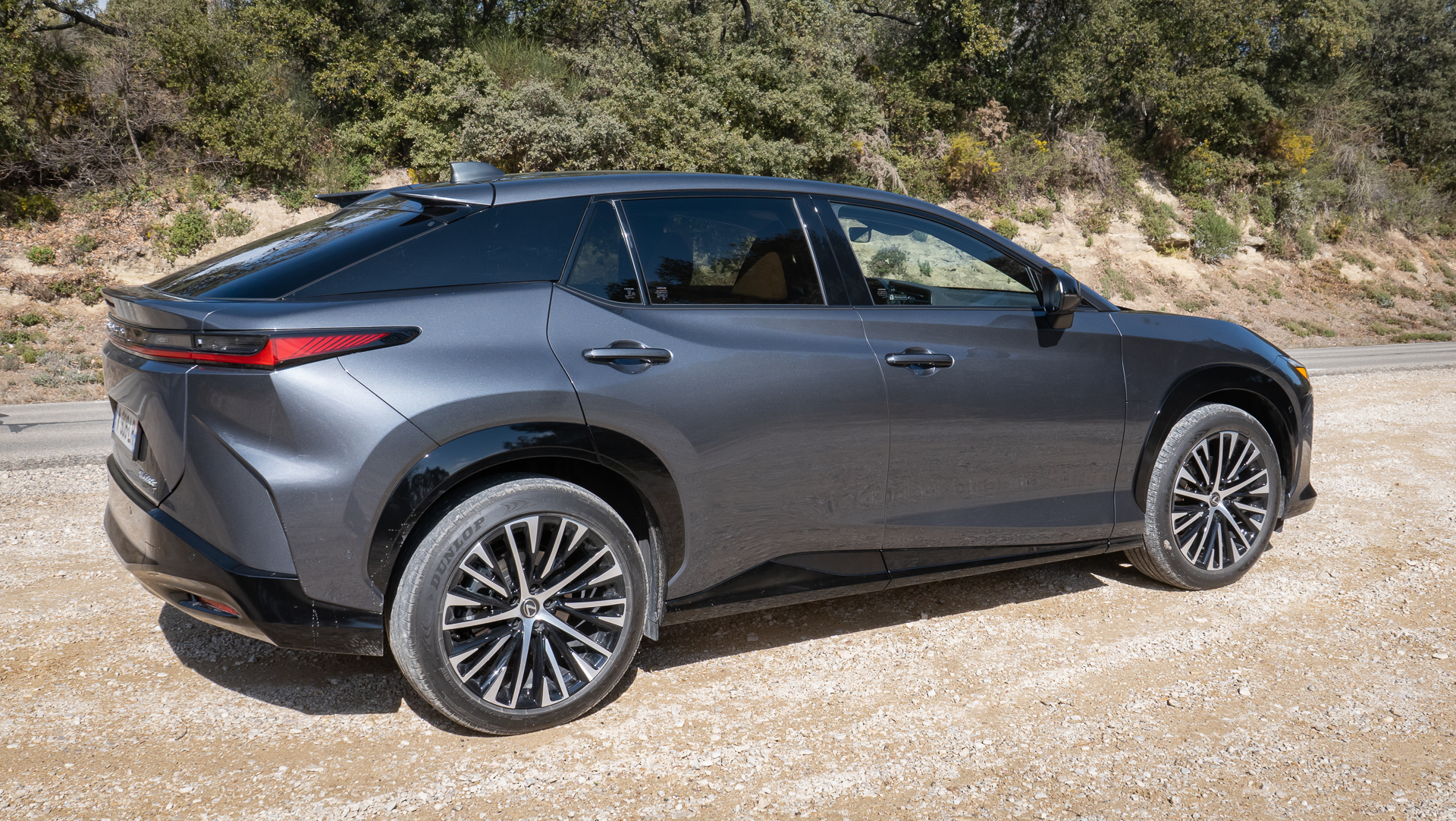
Unlike its Toyota sibling, the Lexus is only offered in a dual-motor configuration, with a system called Direct4 used to switch between front, rear and all-wheel-drive in mere milliseconds, depending on how the car is being driven and what the road surface is like. Lexus says this technology is far quicker at reacting than a mechanical equivalent, and it uses speed, steering input and even G-force to work out how much power should go where.
There’s plenty going on beneath the surface, but in reality it’s impossible to tell which motor is doing what. For a car like this, where the nuances of front vs rear vs all-wheel-drive are entirely irrelevant, ignorance is bliss. What is worth focusing on is how quickly the Lexus launches itself down the road. As is increasingly the case with today’s powerful electric cars, the RZ is far quicker than it has any right to be, sprinting to 62 mph in 5.6 seconds on a wave of torque. Total power output is 313 hp – almost 100 more than the Toyota – with the front motor responsible for up to two-thirds of that.
It’s the sort of performance that raises a smile when exiting a roundabout or joining the motorway – and it makes overtaking a breeze – but more important is the Lexus’ quiet cabin, smooth ride (albeit aided by the billiard-table roads of the test route) and overall refinement.
Cabin, connectivity… and knee warmers
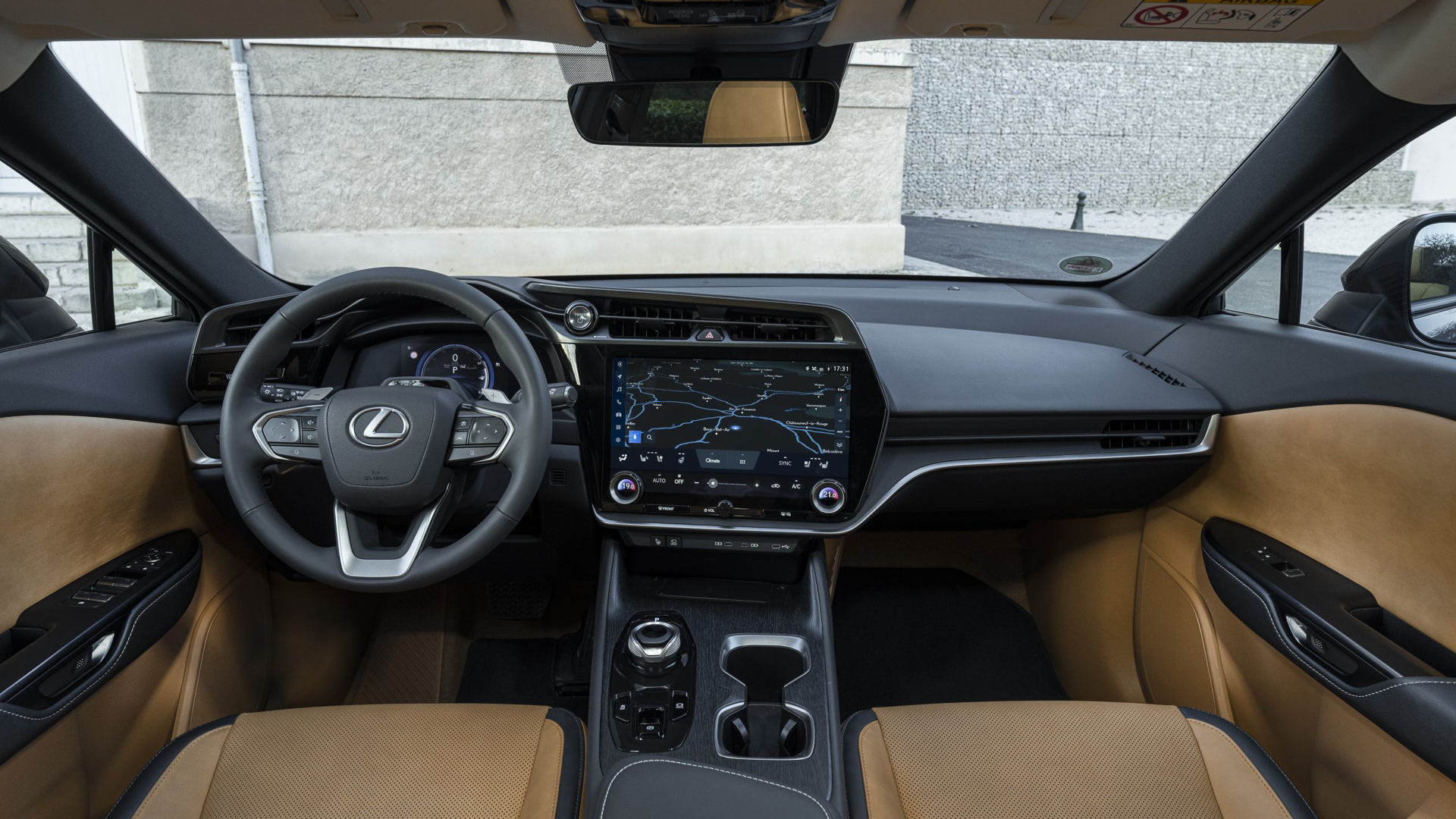
It’s a good looking interior with plenty of tactile switchgear that is easy to use, including rotary dials for the cabin temperature and gear selector. No fewer than three USB-C ports sit below the climate controls and there’s a wireless phone charger too, so all your devices can be topped up at once.
I’m less enamoured by the touchscreen display. At 14 inches it’s positively massive, and to my eyes sits a little awkwardly on the dashboard, like someone has retrofitted a portable CRT television to the centre console. It’s bright, sharp and responsive – and there’s wireless Apple CarPlay and Android Auto – but its size and position, mounted high in the dash, is slightly jarring.
The rest of the cabin has the quality you’d expect from a Lexus, with highlights including a panoramic glass roof that can be dimmed with the press of a button, patterned ambient lighting projected onto the door cards and what Lexus calls “radiant heaters” that blow warm air at your knees from below the dashboard. Sounds strange, but it's actually rather pleasant and, Lexus says, a more energy-efficient way of warming the RZ’s occupants.
Range, charging and efficiency
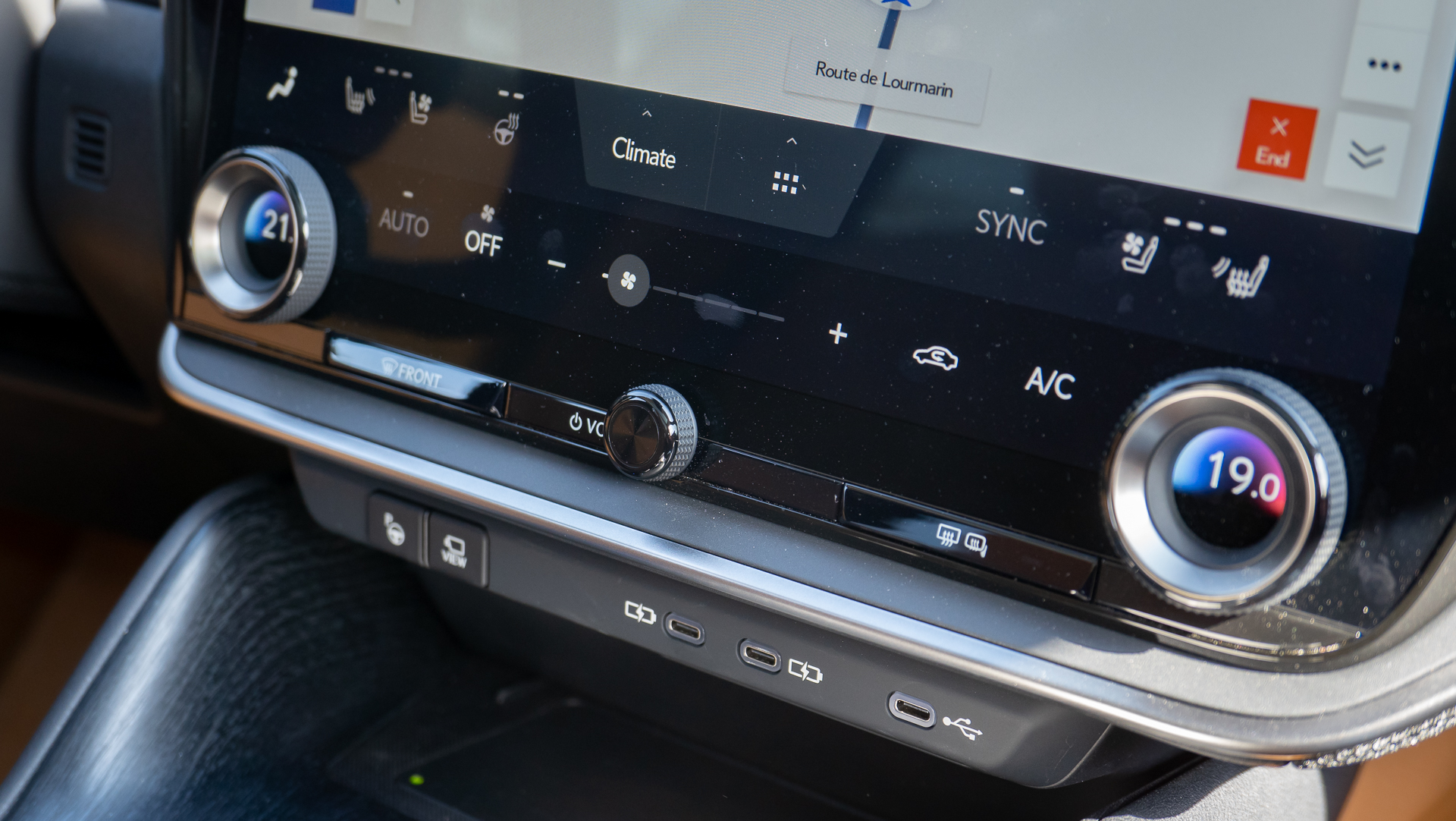
Speaking of energy efficiency, Lexus says the RZ has a range of between 245 and 274 miles. Part of that variation is down to wheel size, and although Lexus expects most buyers to opt for the larger 20in rims, it says they reduce the range by about 25 miles compared to the standard 18 inch option.
Lexus says the RZ should achieve between 3.3 and 3.7 miles per kWh (between 16.8 and 18.7 km kWh per 100km, using the European measurement for EV efficiency), and it’ll charge at up to 150 kW, with a charge to 80 percent taking as little as 15 minutes. We managed to better that efficiency target, hitting an impressive 4.0 miles per kWh during about 75 minutes of driving, albeit not at motorway speed.
Although no doubt helped by the smooth French roads, the Lexus RZ drives well. It is remarkably refined and mostly does a good job of disguising its mass, apart from when it thuds its way over speed bumps.
The steering and braking are both perfectly adequate for a car of this type, and the amount of regenerative braking can be adjusted as you drive using paddles behind the steering wheel. I would personally prefer the option for more aggressive regen, but I suspect many RZ buyers will be acquiring their first electric car, so Lexus has dialled in a milder, more natural regen.
One Motion Grip: Has Lexus reinvented the wheel?
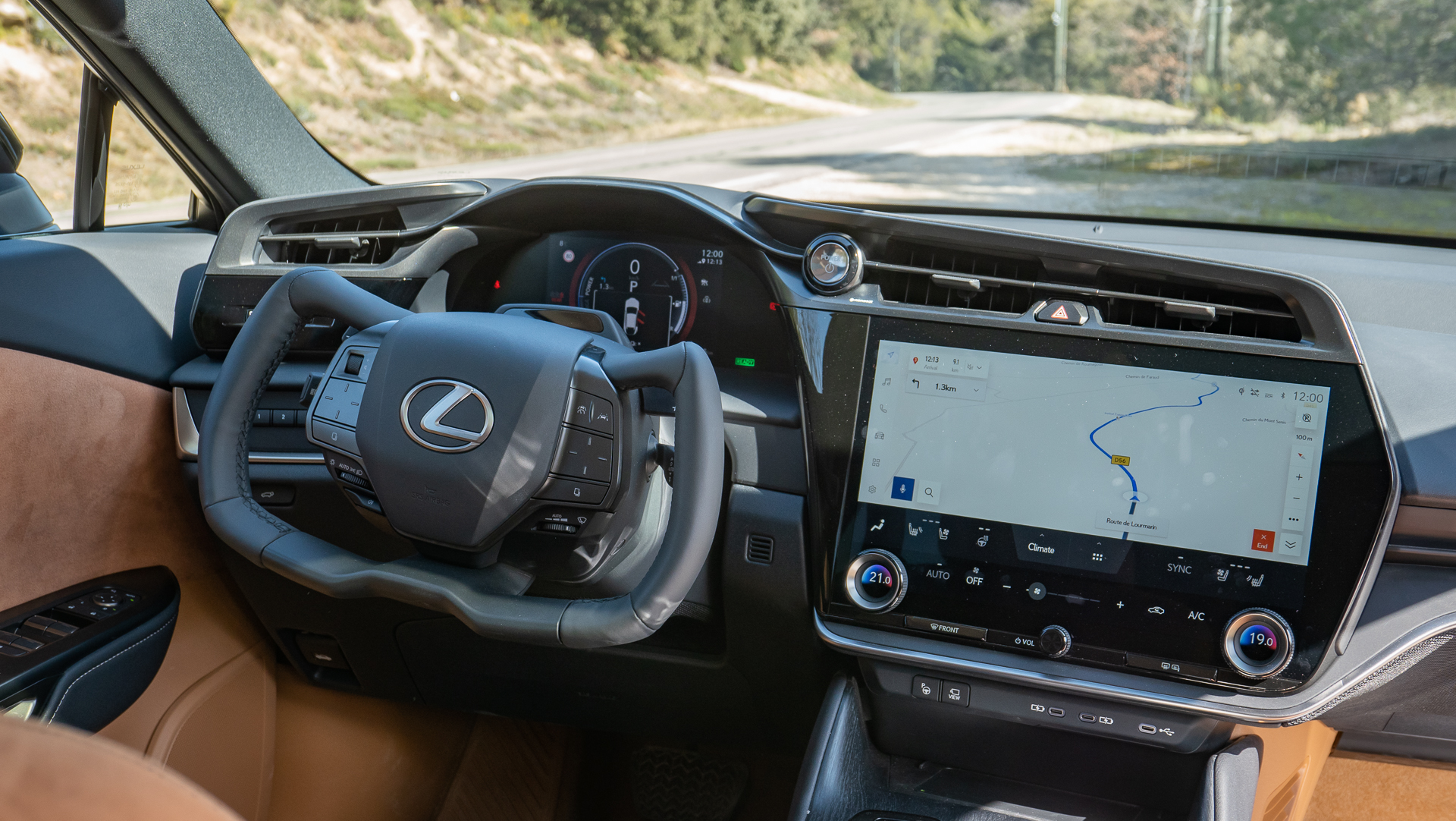
Firstly, it is worth explaining how this is not the same as the yoke-style wheel used by Tesla in the Model S Plaid. That is simply a wheel of a different shape fitted to the same steering system as the regular Model S, whereas the Lexus system is steer-by-wire. This means the wheel, or yoke, is not physically connected to the front wheels, and instead its movement is sensed by a steering torque actuator, which then passes instructions to an electric motor in charge of turning the wheels.
This lack of physical connection gives Lexus the ability to create a variable steering ratio, where the speed at which the front wheels change direction – or by how many degrees they turn, compared to the amount of steering lock applied by the driver – can change, depending on variables like car speed and steering speed.
The result is a yoke that only rotates 150 degrees, but which turns the wheels more quickly at low speed and slower at higher speed. This means parking manoeuvres can be completed without hand-over-hand steering, hence the yoke shape encouraging the driver to keep their hands in the same quarter-to-three position at all times.
Does it work?
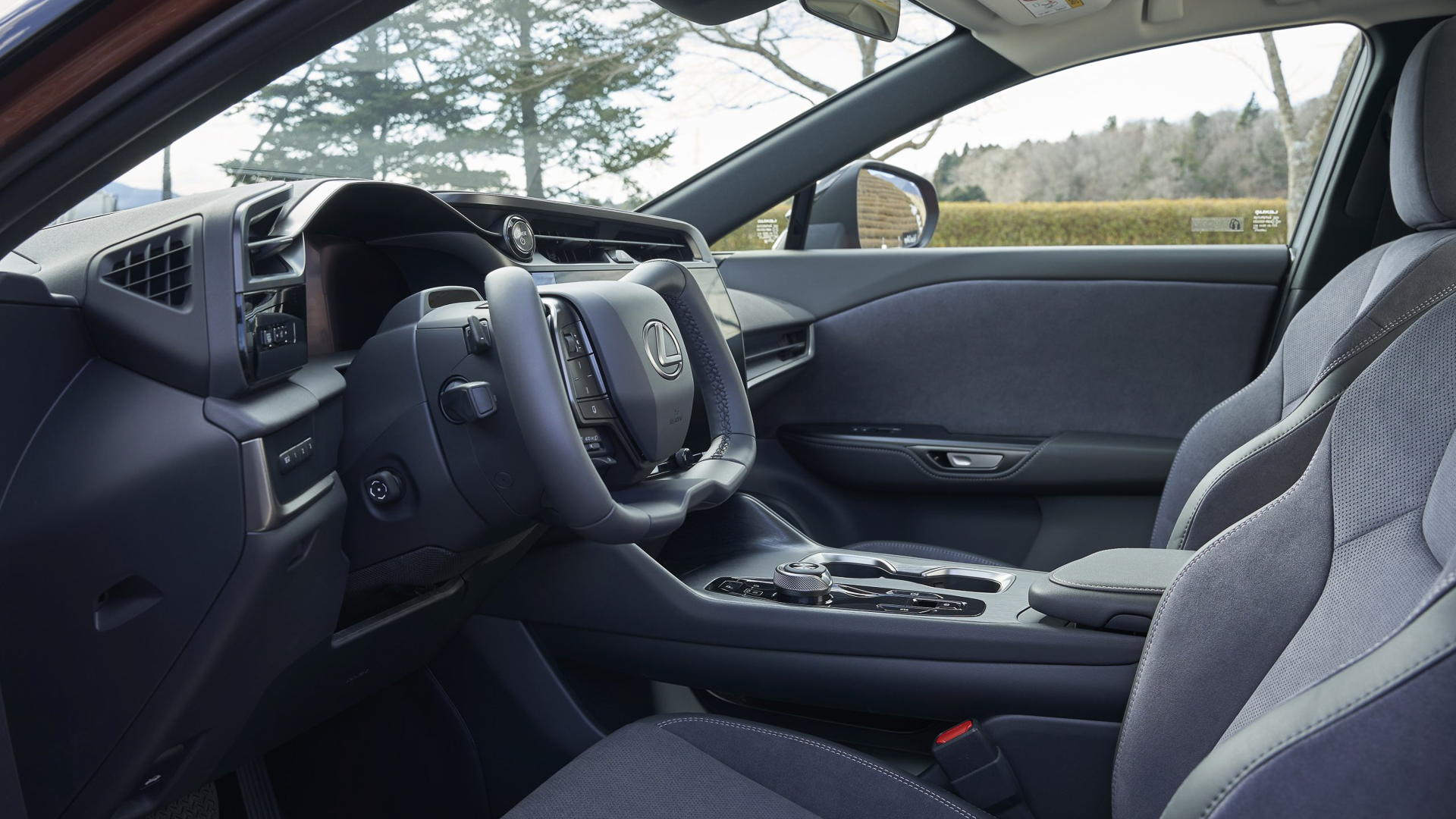
Had you been there, dear reader, you would be forgiven for thinking I was a learner on their first driving lesson. As I pointed the RZ out of the hotel car park and onto a quiet side road, my inputs were sharp and jerky, like those of a teenager unaware of how much steering input is needed to navigate a junction.
During these first few moments, the One Motion Grip took all of the muscle memory I had acquired in 15 years of driving, reset it back to zero and forced me to relearn the basics of car control. My first turn across a junction came with a side-order of panic, as my brain fought against what my eyes, hands and inner-ear were telling it. Convincing your grey matter that you’ve applied enough steering lock to miss a wall, a barrier or a parked car takes real effort, as the car turns more tightly than the amount of steering lock would suggest.
The yoke design also comes with a shorter indicator stalk and smaller paddles for adjusting the regenerative braking. They are all more difficult to use as a result.
I spent about 45 minutes driving with the One Motion Grip, then the same time as a passenger. During this hour-and-a-half my passenger and I talked about nothing else. Initial panic gave way to amusement and eventually confidence, once we had learned to trust the system and recalibrated our minds to sing from the same hymn sheet.
What are the benefits?
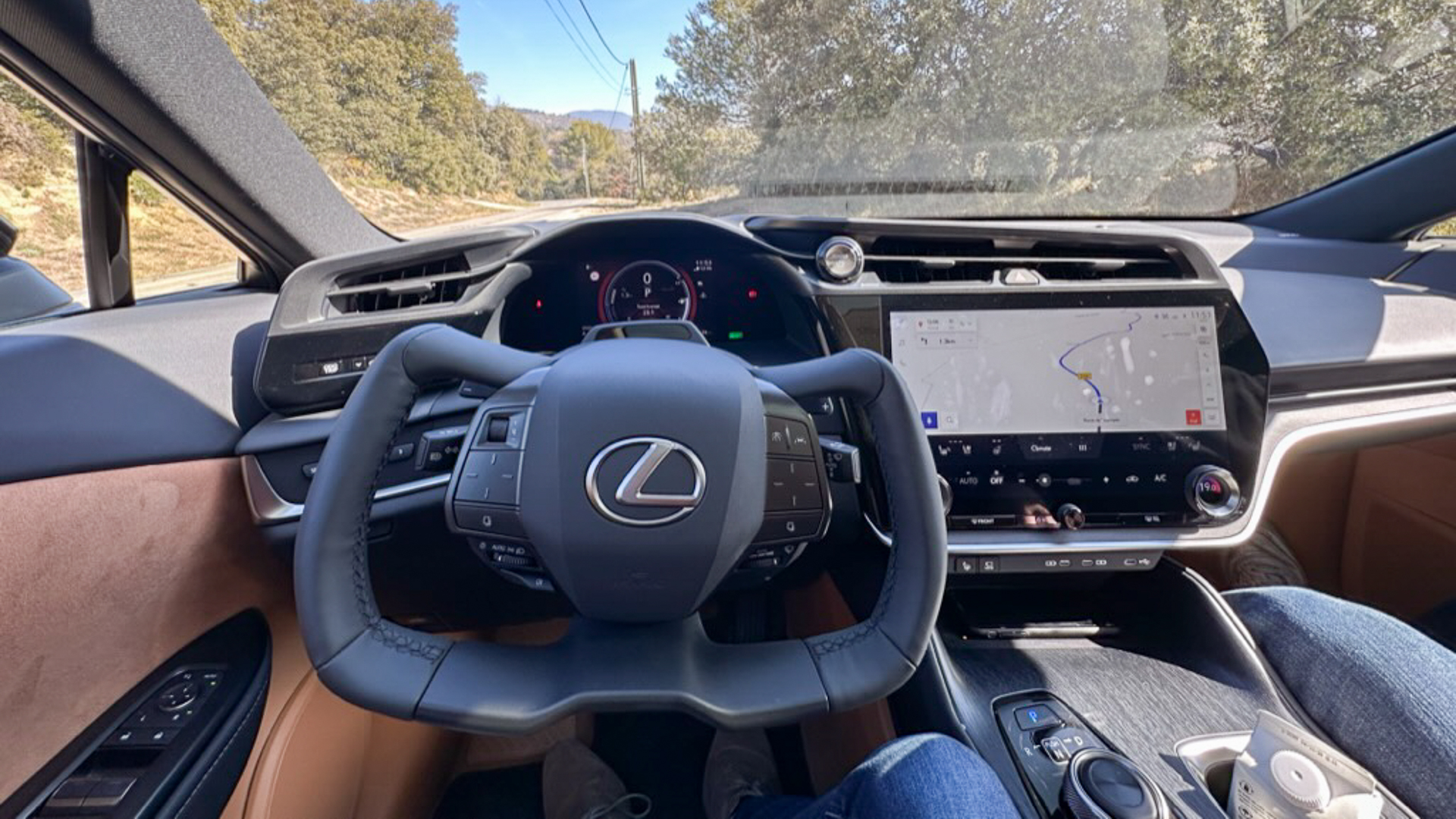
Lexus says the benefits of a variable steering ratio mean an enhanced connection between car and driver, hands that are always on the wheel (sorry, yoke), and less feedback from the tyres and brakes, as there’s no physical connection. A better view of the instrument cluster is also possible, and to this end the RZ’s binnacle is higher and further away than normal.
But, for now at least, I don’t feel the same way. Asking drivers to re-learn something as fundamental as steering, in pursuit of such small gains, feels unnecessary. Drivers may rightly complain about steering wheels covered in frustrating touch pads instead of physical buttons (the RX actually scores well here, with lots of tactility), but when did you last hear anyone complain about having to steer hand-over-hand?
I may be proved wrong between now and 2025 when Lexus plans to put the One Motion Control into production, but for now it feels like a solution to a problem that doesn’t exist. It will certainly make the RZ stand out from an increasingly crowded market of similar electric SUVs, but in such a car the technology feels incongruous.
Using the yoke feels like playing a computer game. There’s nothing wrong with that in isolation, but it doesn’t sit right in a car that also tries to woo customers who, to quote Lexus on the RZ’s heating system, want the feeling of “having a warm blanket wrapped around their legs.”
Lexus RZ first-drive verdict
It feels unfair to include the One Motion Grip in my conclusion, because it isn't finished yet, won’t be available until 2025 and a lot may change between now and then.
As it stands today, with a normal wheel, the RZ is a smartly designed EV with sharp styling, a very smooth and comfortable ride (on the test route, at least), a refined cabin with a novel take on passenger heating, and better-than-expected efficiency. It’s a fair bit more expensive than the Toyota on which it is based, but the RZ comes from a premium brand and I can see plenty of existing Lexus owners using this as an opportunity to buy their first electric car.
Tactile buttons on the steering wheel are welcome in a world increasingly moving to haptic touch controls, and while I’m not fully sold on the bulkiness of the touchscreen, the infotainment system works pretty well and I’m a fan of the ambient lighting.
The RZ isn’t a game-changing EV, but it’s a well-executed first effort from Lexus that offers a slightly left-field alternative to cars from Audi, BMW and Jaguar.
Alistair is a freelance automotive and technology journalist. He has bylines on esteemed sites such as the BBC, Forbes, TechRadar, and of best of all, T3, where he covers topics ranging from classic cars and men's lifestyle, to smart home technology, phones, electric cars, autonomy, Swiss watches, and much more besides. He is an experienced journalist, writing news, features, interviews and product reviews. If that didn't make him busy enough, he is also the co-host of the AutoChat podcast.
-
 Garmin’s on a mission to update your wrist into oblivion as 100+ tweaks land on Fenix and Enduro watches
Garmin’s on a mission to update your wrist into oblivion as 100+ tweaks land on Fenix and Enduro watchesThe latest beta update looks comprehensive
By Matt Kollat Published
-
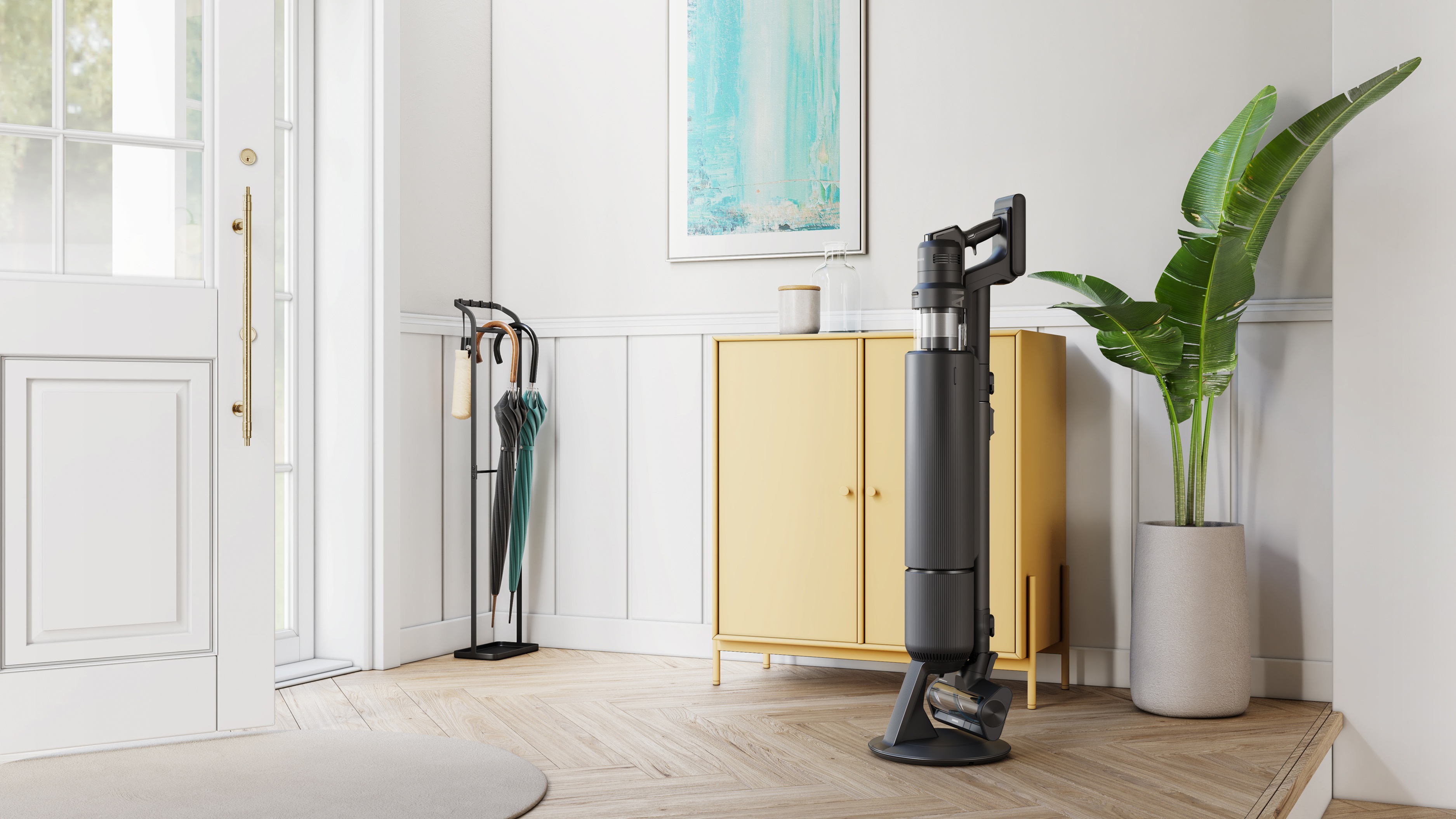 5 reasons you should be excited about the brand new Samsung Bespoke AI Jet Ultra
5 reasons you should be excited about the brand new Samsung Bespoke AI Jet UltraNot sure if it’s obvious... but I can't wait to try it
By Lizzie Wilmot Published